Mybatis3
环境:
- JDK13.0.2
- Mysql 8.0.21
- Maven 3.6.3
- IDEA2020.2
SSM框架(配置文件的):主看官方文档Mybatis3
1.简介
1.1 什么是Mybatis
MyBatis 是一款优秀的持久层框架,它支持自定义 SQL、存储过程以及高级映射。MyBatis 免除了几乎所有的 JDBC 代码以及设置参数和获取结果集的工作。MyBatis 可以通过简单的 XML 或注解来配置和映射原始类型、接口和 Java POJO(Plain Old Java Objects,普通老式 Java 对象)为数据库中的记录。
-
Maven仓库:
<!-- https://mvnrepository.com/artifact/org.mybatis/mybatis --> <dependency> <groupId>org.mybatis</groupId> <artifactId>mybatis</artifactId> <version>3.5.3</version> </dependency> -
Github:https://github.com/mybatis/mybatis-3/releases
-
中文文档:https://mybatis.org/mybatis-3/zh/getting-started.html
1.2持久化
数据持久化
- 持久化就是将程序的数据在持久状态和瞬时状态转化的过程
- 内存:断电即失
- 数据库(JDBC),io文件持久化
对象要求你能持久,你不持久对象就换个持久的
1.3持久层
Dao层,Service层,Controller层···
- 完成持久化工作的代码块
- 层界限明显
2.第一个Mybatis程序
思路:搭建环境–>导入Mybatis–>编写代码–>测试! 学任何新东西都要按照这个流程走
2.1搭建环境
搭建数据库
CREATE DATABASE `mybatis`;
USE `mybatis`;
CREATE TABLE `user`(
`id` INT(20) NOT NULL PRIMARY KEY,
`name` VARCHAR(30) DEFAULT NULL,
`pwd` VARCHAR(30) DEFAULT NULL
)ENGINE=INNODB DEFAULT CHARSET=utf8;
INSERT INTO `user`(`id`,`name`,`pwd`) VALUES
(1,'明叔','123456'),
(2,'SCQ','4jrj3k'),
(3,'wmllk','oodkka')
新建项目(注意:一定要改:由于idea在创建新maven项目时候会自动使用自己C盘的原配置,但我们要放进自己的仓库和使用自己的配置,修改配置请看此链接IDEA修改maven地址配置)
-
新建一个普通的maven项目
-

这里不勾选
-

此处按自己信息填写即可
-
-
删除src目录
-
导入maven依赖
<dependencies> <!-- mysql驱动--> <dependency> <groupId>mysql</groupId> <artifactId>mysql-connector-java</artifactId> <version>8.0.21</version> </dependency> <!-- mybatis--> <dependency> <groupId>org.mybatis</groupId> <artifactId>mybatis</artifactId> <version>3.5.3</version> </dependency> <!-- junit--> <dependency> <groupId>junit</groupId> <artifactId>junit</artifactId> <version>4.12</version> <scope>test</scope> </dependency> </dependencies>
2.2创建一个模块
-
编写mybatis的核心配置文件
<?xml version="1.0" encoding="UTF-8" ?> <!DOCTYPE configuration PUBLIC "-//mybatis.org//DTD Config 3.0//EN" "http://mybatis.org/dtd/mybatis-3-config.dtd"> <!--configuration核心配置文件--> <configuration> <environments default="development"> <environment id="development"> <transactionManager type="JDBC"/> <dataSource type="POOLED"> <property name="driver" value="com.mysql.cj.jdbc.Driver"/> <property name="url" value="jdbc:mysql://localhost:3306/mybatis?useUnicode=true&characterEncoding=utf-8&useSSL=true&serverTimezone=GMT%2B8"/> <property name="username" value="root"/> <property name="password" value="514322"/> </dataSource> </environment> </environments> </configuration> -
编写mybatis工具类
//工具类 SqlSessionFactory public class MybatisUtils { private static SqlSessionFactory sqlSessionFactory; static { try { //使用Mybatis获取SqlSessionFactory对象 String resource = "mybatis-config.xml"; InputStream inputStream = Resources.getResourceAsStream(resource); sqlSessionFactory = new SqlSessionFactoryBuilder().build(inputStream); } catch (IOException e) { e.printStackTrace(); } } //既然有了 SqlSessionFactory,顾名思义,我们可以从中获得 SqlSession 的实例。 // SqlSession 提供了在数据库执行 SQL 命令所需的所有方法。 // 你可以通过 SqlSession 实例来直接执行已映射的 SQL 语句。 public static SqlSession getSqlSession(){ return sqlSessionFactory.openSession(); } //学会经常优化代码,使其更加简洁,如源代码: // SqlSession sqlSession = sqlSessionFactory.openSession(); // return sqlSession;
2.3编写代码
-
实体类
//实体类 public class User { private int id; private String name; private String pwd; public User() { } public User(int id, String name, String pwd) { this.id = id; this.name = name; this.pwd = pwd; } public int getId() { return id; } public void setId(int id) { this.id = id; } public String getName() { return name; } public void setName(String name) { this.name = name; } public String getPwd() { return pwd; } public void setPwd(String pwd) { this.pwd = pwd; } @Override public String toString() { return "User{" + "id=" + id + ", name='" + name + '\'' + ", pwd='" + pwd + '\'' + '}'; } } -
Dao接口
public interface UserDao { List<User> getUserList(); } -
接口实现类由原来的UserDaoImpl转变为一个Mapper配置文件
<?xml version="1.0" encoding="UTF-8" ?> <!DOCTYPE mapper PUBLIC "-//mybatis.org//DTD Mapper 3.0//EN" "http://mybatis.org/dtd/mybatis-3-mapper.dtd"> <!--命名空间(Namespaces)绑定一个Dao/Mapper接口--> <mapper namespace="com.sun.dao.UserDao"> <select id="getUserList" resultType="com.sun.pojo.User"> select * from mybatis.user </select> </mapper>id对应的是接口里面声明的方法名,结果类别就是接口中声明的泛型
2.4测试
注意点:org.apache.ibatis.binding.BindingException: Type interface com.sun.dao.UserDao is not known to the MapperRegistry.
MapperRegistry是什么?
核心配置文件中注册mappers
-
junit测试(test文件的路径尽量与上面代码的结构一致,符合代码规范)
public class UserDaoTest { @Test public void test(){ //第一步:获取sqlSession对象 SqlSession sqlSession = MybatisUtils.getSqlSession(); //第二步:方法一:getMapper UserDao userDao = sqlSession.getMapper(UserDao.class); List<User> userList = userDao.getUserList(); for (User user : userList) { System.out.println(user); } //关闭sqlSession sqlSession.close(); } }可能遇到的问题:
- 配置文件没有注册
- 绑定接口错误
- 方法名不对
- 返回类型不对
- Maven导出资源问题
注意在核心配置文件里加入如下过滤,防止出现异常
<!-- 在build中配置resources,来防止我们资源导出失败的问题--> <build> <resources> <resource> <!-- 设定主资源目录 --> <directory>src/main/resources</directory> <includes> <include>**/*.properties</include> <include>**/*.xml</include> </includes> </resource> <resource> <directory>src/main/java</directory> <includes> <include>**/*.properties</include> <include>**/*.xml</include> </includes> <filtering>false</filtering> </resource> </resources> </build>
3.CRUD
1.namespace
namespace中的包名要和接口的包名一致!
2.select
选择,查询语句
- id:对应的namespace中的方法名;
- resultType:sql语句执行的返回值!
- parameterType:参数类型!
-
编写接口
//根据ID查询用户 User getUserById(int id); -
编写对应的mapper中的sql语句
<select id="getUserById" resultType="com.sun.pojo.User" parameterType="int"> select * from mybatis.user where id = #{id} </select> -
测试
@Test public void getUserById(){ SqlSession sqlSession = MybatisUtils.getSqlSession(); UserMapper mapper = sqlSession.getMapper(UserMapper.class); User user = mapper.getUserById(2); System.out.println(user); sqlSession.close(); }
3.Insert
<insert id="addUser" parameterType="com.sun.pojo.User">
insert into mybatis.user (id, name, pwd) VALUES (#{id},#{name},#{pwd});
</insert>
4.Update
<update id="updateUser" parameterType="com.sun.pojo.User">
update mybatis.user set name=#{name},pwd=#{pwd} where id = #{id};
</update>
5.Delete
<delete id="deleteUser" parameterType="int">
delete from mybatis.user where id = #{id};
</delete>
注意点!!!!!!!!增删改需要提交事务
sqlSession.commit();
6.万能Map
假设,我们的实体类,或者数据库中的表,字段或者参数过多,我们应当考虑使用Map!
int addUser2(Map<String,Object> map);
<!--传递map中的key-->
<insert id="addUser2" parameterType="map">
insert into mybatis.user (id, pwd) VALUES (#{userid},#{password});
</insert>
@Test
public void addUser2(){
SqlSession sqlSession = MybatisUtils.getSqlSession();
UserMapper mapper = sqlSession.getMapper(UserMapper.class);
HashMap<String, Object> map = new HashMap<>();
map.put("userid", "5");
map.put("username", "吼哒");
map.put("password", "5f3536");
mapper.addUser2(map);
sqlSession.commit();
sqlSession.close();
}
Map传递参数,直接在sql中取出key即可!parameterType=“map”
对象传递参数,直接在sql中取对象的属性即可!parameterType=“Object”
只有一个基本类型参数的情况下,可以在sql中直接取到!
多个参数用map,或者注解
7.模糊查询
//模糊查询
List<User> getUserLike(String value);
<select id="getUserLike" resultType="com.sun.pojo.User">
select * from mybatis.user where name like #{value}
</select>
@Test
public void getUserLike(){
SqlSession sqlSession = MybatisUtils.getSqlSession();
UserMapper mapper = sqlSession.getMapper(UserMapper.class);
List<User> userList = mapper.getUserLike("%李%");
for (User user : userList) {
System.out.println(user);
}
sqlSession.close();
}
java代码执行的时候,传递通配符 % %
在sql拼接中使用通配符!
4.配置解析
1.核心配置文件
- mybatis-config.xml
- Mybatis的配置文件包含了会深深影响Mybatis行为的设置和属性信息
configuration(配置)
properties(属性)
settings(设置)
typeAliases(类型别名)
typeHandlers(类型处理器)
objectFactory(对象工厂)
plugins(插件)
environments(环境配置)
environment(环境变量)
transactionManager(事务管理器)
dataSource(数据源)
databaseIdProvider(数据库厂商标识)
mappers(映射器)
2.环境配置(environments)
MyBatis 可以配置成适应多种环境
不过要记住:尽管可以配置多个环境,但每个 SqlSessionFactory 实例只能选择一种环境。
学会使用配置多套环境!如配置oracle的数据库环境等,应对不同开发场景,使用的时候在default里选就行了
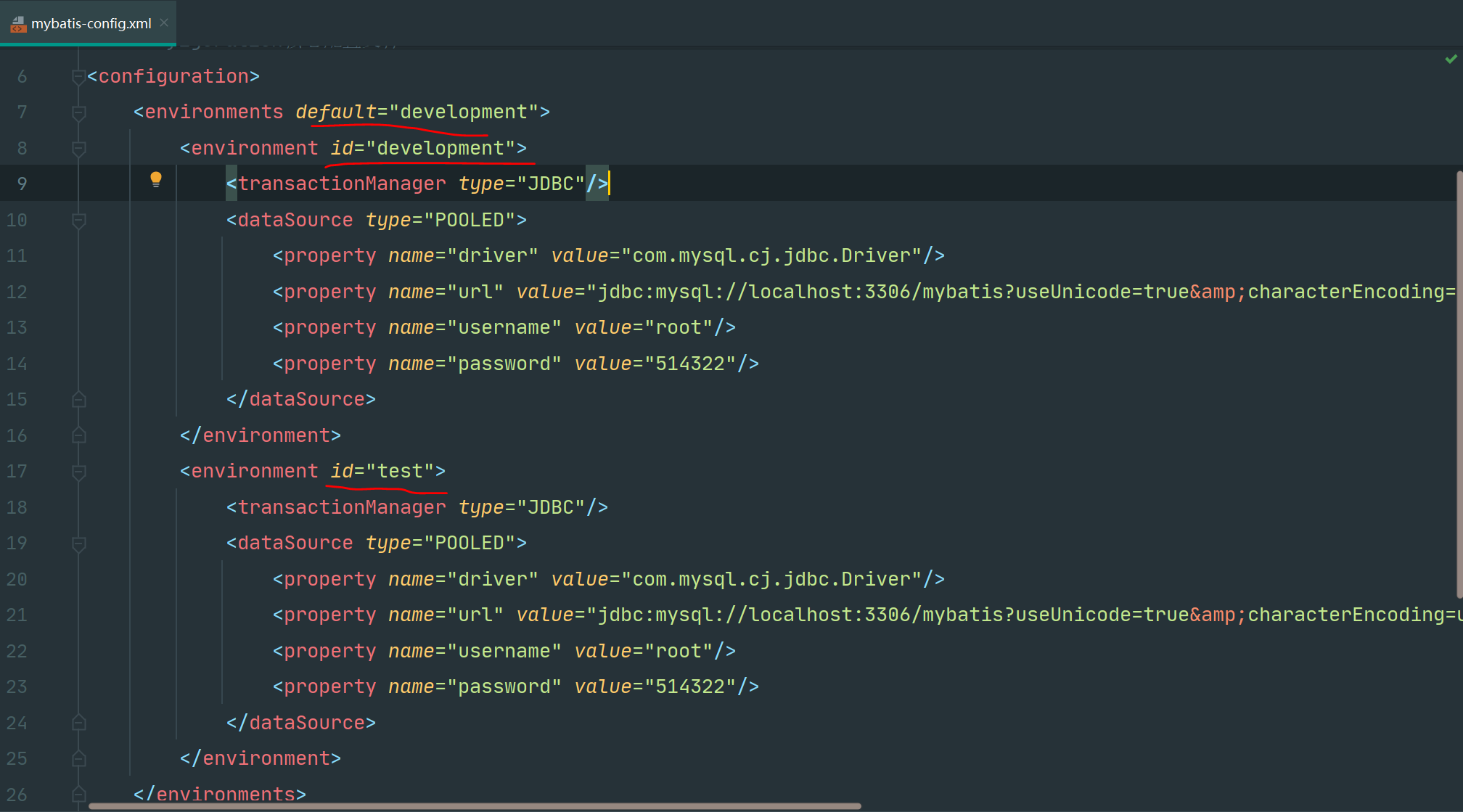
Mybatis默认的事务管理器就是JDBC(还有一个是Managed,但是基本不用),数据库连接池:POOLED
3.属性(properties)
可以通过properties属性实现引用配置文件
这些属性可以在外部进行配置,并可以进行动态替换。既可以在典型的 Java 属性文件中配置这些属性,也可以在 properties 元素的子元素中设置。【db.properties】
编写一个配置为文件db.properties
driver=com.mysql.cj.jdbc.Driver
url=jdbc:mysql://localhost:3306/mybatis?useUnicode=true&characterEncoding=utf-8&useSSL=false&serverTimezone=GMT%2B8&allowPublicKeyRetrieval=true
username=root
password=514322
在核心配置文件中引入
<properties resource="db.properties">
<property name="username" value="root"/>
<property name="password" value="514322"/>
</properties>
- 可以直接引入外部文件
- 可以在其中增加一些属性配置
- 如果两个文件有同一个字段,如同时写了数据库的账号和密码,则系统会优先使用外部配置文件!
4.类型别名(typeAliases)
- 类型别名可为 Java 类型设置一个缩写名字。
- 它仅用于 XML 配置,意在降低冗余的全限定类名书写。
<!-- 可以给实体类起别名-->
<typeAliases>
<typeAlias type="com.sun.pojo.User" alias="User"/>
</typeAliases>
也可以指定一个包名,MyBatis 会在包名下面搜索需要的 Java Bean
扫描实体类的包(如pojo),它的默认别名就为这个类的类名,首字母小写!
<typeAliases>
<package name="com.sun.pojo"/>
</typeAliases>
在实体类比较小的时候使用第一种方式来取别名,在实体类比较大的时候建议使用第二种!
第一种可以DIY,第二种起别名不是很方便,需要在实体类上添加注解,如下:
@Alias("hello")
public class User {}

5.设置
常见的如下:


学了spring之后这些就不用了
6.映射器(mappers)
MapperRegistry:注册绑定我们的Mapper文件(官网有四种,但不需要全部会用)
方式一:使用相对于类路径的资源引用
<!--每一个Mapper.xml都需要在Mybatis的核心配置文件中注册-->
<mappers>
<mapper resource="com/sun/dao/UserMapper.xml"/>
</mappers>
方式二:使用class文件绑定注册
<mappers>
<!-- <mapper resource="com/sun/dao/UserMapper.xml"/>-->
<mapper class="com.sun.dao.UserMapper"/>
</mappers>
注意点:
- 接口和他的Mapper配置文件必须同名
- 接口和他的Mapper配置文件必须在同一个包下!
7.生命周期和作用域
生命周期和作用域是至关重要的,因为错误的使用会导致非常严重的并发问题。
SqlSessionFactoryBuilder:
- 一旦创建了SqlSessionFactory,就不需要了
- 局部变量
SqlSessionFactory:
- 可以认为是数据库连接池,创建后就一直存在
- 没有任何理由丢弃他或重新创建另一个实例
- 最简单的就是使用单例模式或者静态单例模式
- SqlSessionFactory的最佳作用域是应用作用域
SqlSession:
-
每个线程都应该有自己的SqlSession实例
-
连接到连接池的一个请求
-
用完后需要马上关闭
sqlSession.close();
5.解决属性名和字段名不一致问题
1.问题
数据库中的字段
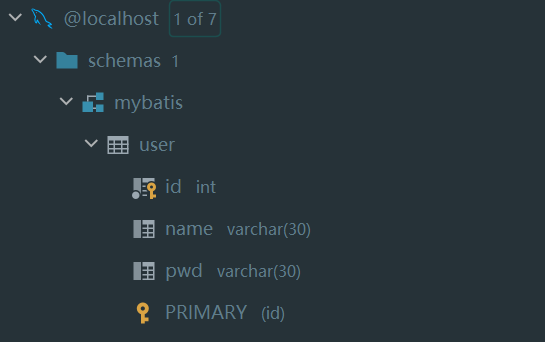
新建一个项目,copy之前的,测试实体类字段不一致的情况
public class User {
private int id;
private String name;
private String password;}
测试出现问题:
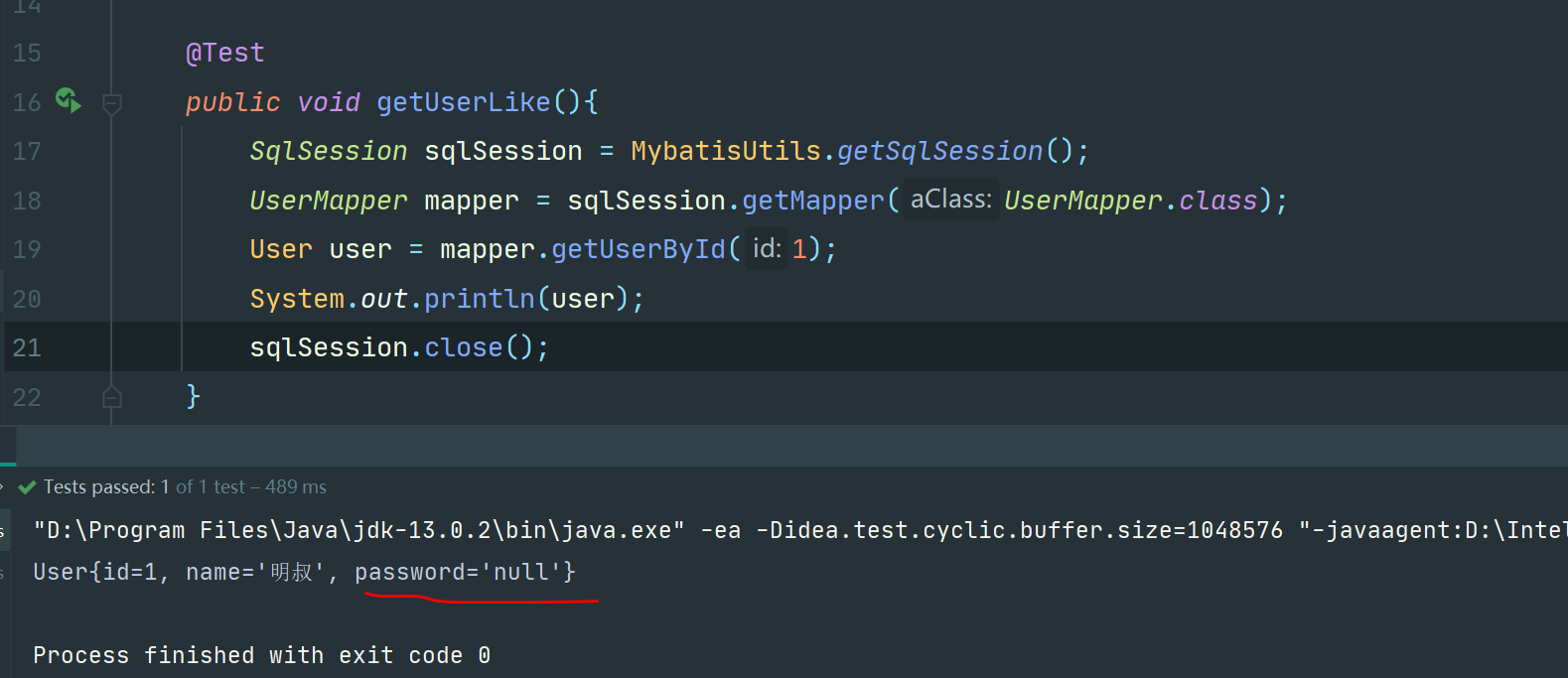
// select * from mybatis.user where id = #{id}
// 类型处理器
// select id,name,pwd from mybatis.user where id = #{id}
解决方法:
-
起别名
<select id="getUserById" resultType="com.sun.pojo.User" parameterType="int"> select id, name, pwd as password from mybatis.user where id = #{id} </select>
2.resultMap
结果集映射
id name pwd
id name password
<!--结果集映射-->
<resultMap id="UserMap" type="User">
<!--column数据库中的字段,property实体类中的属性-->
<result column="id" property="id"/>
<result column="name" property="name"/>
<result column="pwd" property="password"/>
</resultMap>
<select id="getUserById" resultMap="UserMap" parameterType="int">
select * from mybatis.user where id = #{id}
</select>
-
resultMap元素是 MyBatis 中最重要最强大的元素。 -
ResultMap 的设计思想是,对简单的语句做到零配置,对于复杂一点的语句,只需要描述语句之间的关系就行了。
-
你会发现上面的例子没有一个需要显式配置
ResultMap,这就是ResultMap的优秀之处——你完全可以不用显式地配置它们。也就是上面的resultMap中的id和name都用写,只需要写需要改变的就行了
-
==如果这个世界总是这么简单就好了。==后面会有更加复杂的数据库,所以这类简单的其实也不是很需要用到这个知识
6.日志
1.日志工厂
如果一个数据库操作出现了异常,需要排错,所以用日志

重点:LOG4J,STDOUT_LOGGING
在Mybatis中具体使用哪一个,在设置中设定!
STDOUT_LOGGING标准日志输出
在mybatis核心配置文件中,配置我们的日志!
<settings>
<setting name="logImpl" value="STDOUT_LOGGING"/>
</settings>
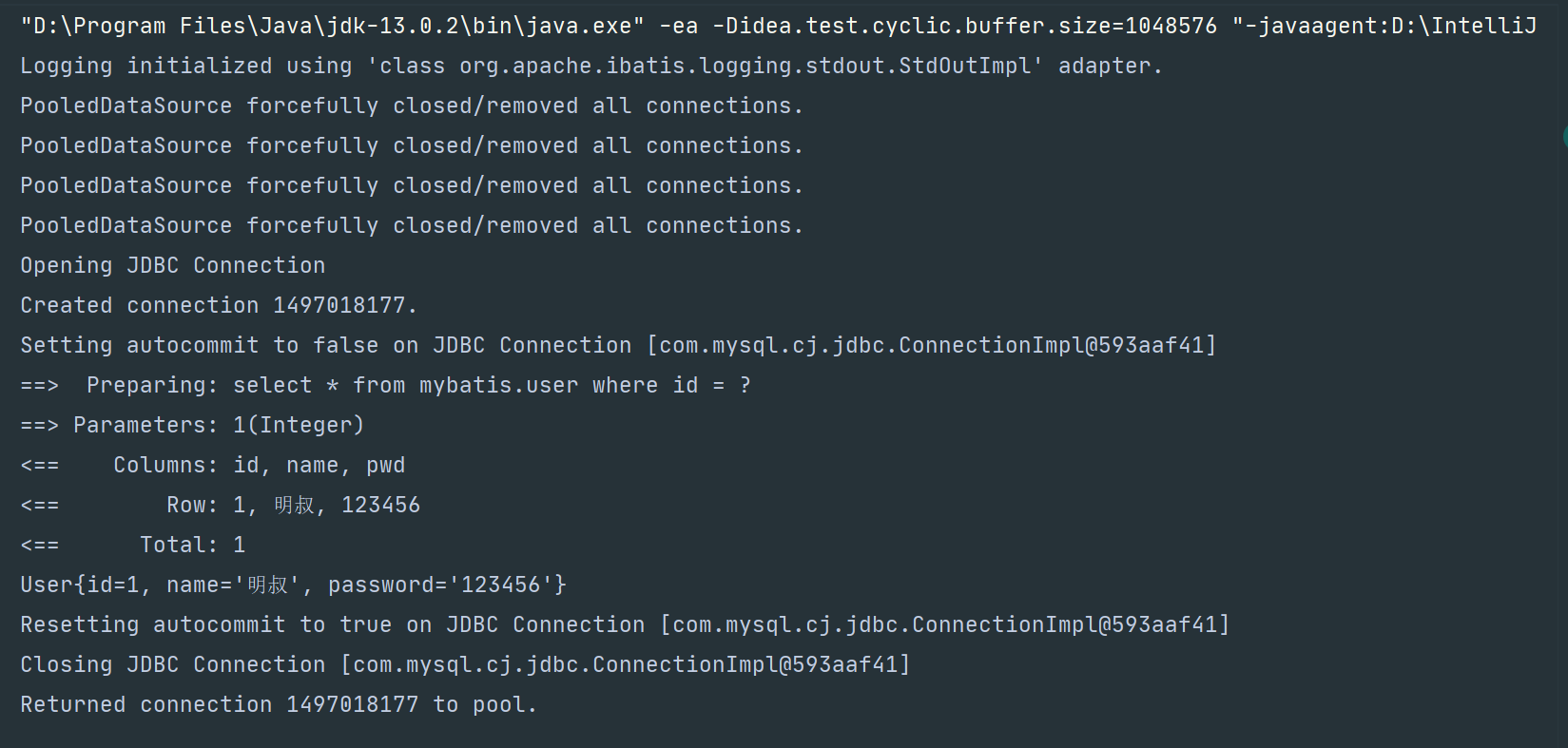
2.LOG4J
- Log4j是Apache的一个开源项目,通过使用Log4j,我们可以控制日志信息输送的目的地是控制台、文件、GUI组件,甚至是套接口服务器、NT的事件记录器、UNIX Syslog守护进程等
- 可以控制每一条日志的输出格式
- 可以定义每一条日志信息的级别
- 可以通过一个配置文件来灵活地进行配置,而不需要修改应用的代码
-
先导包
<!-- https://mvnrepository.com/artifact/log4j/log4j --> <dependency> <groupId>log4j</groupId> <artifactId>log4j</artifactId> <version>1.2.17</version> </dependency> -
log4j.properties
#将等级为DEBUG的日志信息输出到console和file这两个目的地,console和file的定义在下面的代码 log4j.rootLogger=DEBUG,console,file #控制台输出的相关配置 log4j.appender.console = org.apache.log4j.ConsoleAppender log4j.appender.console.Target = System.out log4j.appender.console.Threshold = DEBUG log4j.appender.console.layout = org.apache.log4j.PatternLayout log4j.appender.console.layout.ConversionPattern = [%c]-%m%n #文件输出的相关配置 log4j.appender.file = org.apache.log4j.RollingFileAppender log4j.appender.file.File =./log/sun.log log4j.appender.file.MaxFileSize=10mb log4j.appender.file.Threshold=DEBUG log4j.appender.file.layout=org.apache.log4j.PatternLayout log4j.appender.file.layout.ConversionPattern=[%p][%d{yy-MM-dd}][%c]%m%n #日志输出级别 log4j.logger.org.mybatis=DEBUG log4j.logger.java.sql=DEBUG log4j.logger.java.sql.Statement=DEBUG log4j.logger.java.sql.ResultSet=DEBUG log4j.logger.java.sql.PreparedStatement=DEBUG -
配置log4j为日志的实现
<settings> <setting name="logImpl" value="LOG4J"/> </settings> -
LOG4J的使用!直接测试运行刚才的查询

简单使用
-
在要使用log4j 的类中,导入包
import org.apache.log4j.Logger; -
日志对象,参数为当前类的class
static Logger logger = Logger.getLogger(UserMapperTest.class); -
日志级别
logger.info("info:进入了testLog4j"); logger.debug("debug:进入了testLog4j"); logger.error("error:进入了testLog4j");
7.分页
思考:为什么要分页?
- 减少数据的处理量
1.使用Limit分页(本质还是sql)
使用Limit分页
select * from user limit startIndex,pageSize;

这就代表从位置为0的地方开始查,查两个数

这个3就是显示个数,前面默认为0
使用Mybatis实现分页,核心是SQL
-
接口
//分页 List<User> getUserByLimit(Map<String,Integer> map); -
Mapper.xml
<!-- 分页--> <select id="getUserByLimit" parameterType="map" resultMap="UserMap"> select * from mybatis.user limit #{startIndex},#{pageSize} </select> -
测试
@Test public void getUserByLimit(){ SqlSession sqlSession = MybatisUtils.getSqlSession(); UserMapper mapper = sqlSession.getMapper(UserMapper.class); HashMap<String, Integer> map = new HashMap<>(); map.put("startIndex", 0); map.put("pageSize", 2); List<User> userList = mapper.getUserByLimit(map); for (User user : userList) { System.out.println(user); } sqlSession.close(); }
2.RowBounds分页
不再使用SQL实现分页
-
接口
//RowBounds分页(用的很少) List<User> getUserByRowBounds(); -
mapper.xml
<select id="getUserByRowBounds" resultMap="UserMap"> select * from mybatis.user </select> -
测试
@Test public void getUserByRowBounds(){ SqlSession sqlSession = MybatisUtils.getSqlSession(); //RowBounds实现 RowBounds rowBounds = new RowBounds(1, 2); //通过Java代码实现分页 List<User> userList = sqlSession.selectList("com.sun.dao.UserMapper.getUserByRowBounds",null,rowBounds); for (User user : userList) { System.out.println(user); } sqlSession.close(); }
8.使用注解开发
1.面向接口编程
在一个面向对象的系统中,系统的各种功能是由许许多多的不同对象协作完成的。在这种情况下,各个对象内部是如何实现自己的,对系统设计人员来讲就不那么重要了;而各个对象之间的协作关系则成为系统设计的关键。小到不同类之间的通信,大到各模块之间的交互,在系统设计之初都是要着重考虑的,这也是系统设计的主要工作内容。面向接口编程就是指按照这种思想来编程。
根本原因:解耦,提高复用,分层开发时,上层不用考虑具体的实现,所有开发人员共同遵守相同的标准,使得开发效率更高,规范性更好
三个面向的区别:
- 是指,我们考虑问题时,以对象为单位,考虑它的属性及方法
- 面向过程是指,我们考虑问题时,以一个具体的流程(事务过程)为单位,考虑它的实现
- 面向interface编程,原意是指面向抽象协议编程,实现者在实现时要严格按协议来办。面向对象编程是指面向抽象和具象。抽象和具象是矛盾的统一体,不可能只有抽象没有具象。一般懂得抽象的人都明白这个道理。 但有的人只知具象却不知抽象为何物。 所以只有interface没有实现,或只有实现而没有interface者是没有用的,反OO的。
2.使用注解开发
-
注解在接口上实现
@Select("select * from user") List<User> getUsers(); -
然后在核心配置文件中绑定接口
<!-- 绑定接口--> <mappers> <mapper class="com.sun.dao.UserMapper"/> </mappers> -
测试
本质:反射机制实现
底层:动态代理!
注:java SE基础重新看一看
MyBatis详细执行流程

3.注解的CRUD
我们可以在工具类创建的时候实现自动提交事务!(MyBatisUtils.java)

写测试类或实现类的时候就**不需要再去写sqlSession.commit( );**了
方法存在多个参数时,加上@Param标签
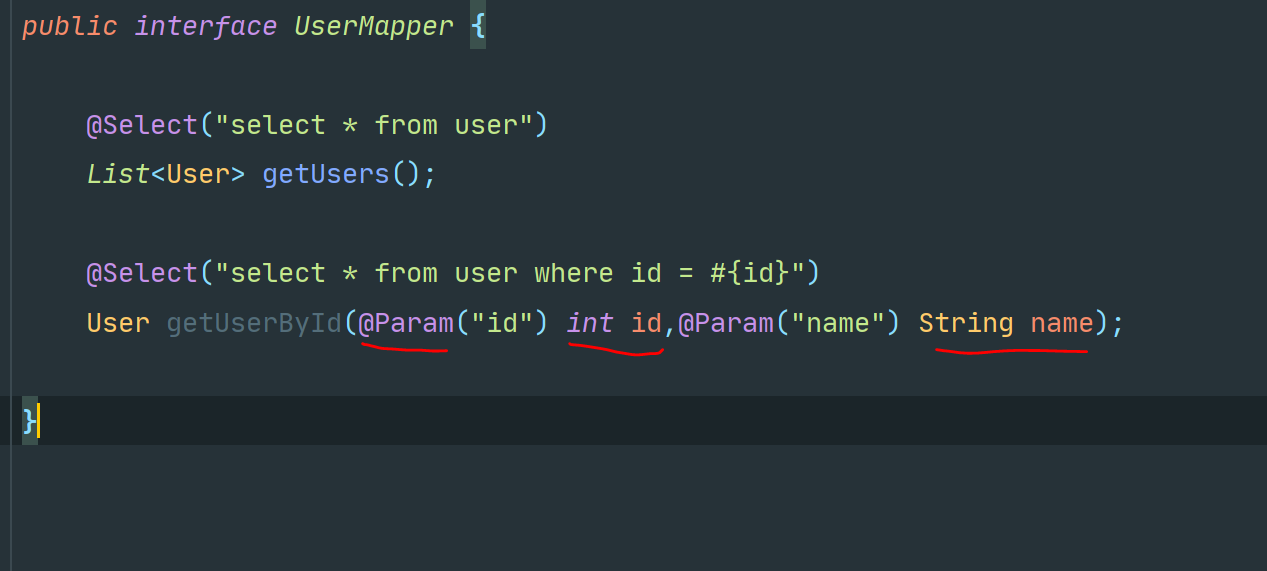
编写接口,增加注解
public interface UserMapper {
@Select("select * from user")
List<User> getUsers();
//方法存在多个参数时,所有的参数前面必须加上@Param(" ")注解
@Select("select * from user where id = #{id}")
User getUserById(@Param("id") int id);
@Insert("insert into user(id,name,pwd) values (#{id},#{name},#{password})")
int addUser(User user);
@Update("update user set name=#{name},pwd=#{password} where id = #{id}")
int updateUser(User user);
@Delete("delete from user where id = #{id}")
int deleteUser(int id);
}
测试类
重点注意:必须记得把mapper接口注册到核心文件中!!!!!!!!
关于@Param()注解
- 基本类型的参数或者String类型,需要加上
- 引用类型不需要加
- 如果只有一个基本类型的话,可以忽略,但保险起见还是加上
- 在SQL中引用的就是在@Param(" ")中设定的属性名
9.Lombok
使用步骤:
-
IDEA安装Lombok插件
-
Maven导入jar包
-
在实体类上写注解
@Getter and @Setter @FieldNameConstants @ToString @EqualsAndHashCode @AllArgsConstructor, @RequiredArgsConstructor and @NoArgsConstructor @Log, @Log4j, @Log4j2, @Slf4j, @XSlf4j, @CommonsLog, @JBossLog, @Flogger, @CustomLog @Data @Builder @SuperBuilder @Singular @Delegate @Value @Accessors @Wither @With @SneakyThrows常用:
@Data:直接生成无参构造、get、set、toString、hashcode、equals @AllArgsConstructor 有参构造 @NoArgsConstructor 无参构造 @EqualsAndHashCode @ToString
10.多对一处理
多对一:

- 多个学生对应一个老师
- 对于学生而言,关联----多个学生关联一个老师 多对一=
- 对于老师而言,集合----一个老师有很多学生 一对多
sql:
CREATE TABLE `teacher` (
`id` INT(10) NOT NULL,
`name` VARCHAR(30) DEFAULT NULL,
PRIMARY KEY (`id`)
) ENGINE=INNODB DEFAULT CHARSET=utf8
INSERT INTO teacher(`id`, `name`) VALUES (1, '孙老师');
CREATE TABLE `student` (
`id` INT(10) NOT NULL,
`name` VARCHAR(30) DEFAULT NULL,
`tid` INT(10) DEFAULT NULL,
PRIMARY KEY (`id`),
KEY `fktid` (`tid`),
CONSTRAINT `fktid` FOREIGN KEY (`tid`) REFERENCES `teacher` (`id`)
) ENGINE=INNODB DEFAULT CHARSET=utf8
INSERT INTO `student` (`id`, `name`, `tid`) VALUES ('1', '小明', '1');
INSERT INTO `student` (`id`, `name`, `tid`) VALUES ('2', '小红', '1');
INSERT INTO `student` (`id`, `name`, `tid`) VALUES ('3', '小张', '1');
INSERT INTO `student` (`id`, `name`, `tid`) VALUES ('4', '小李', '1');
INSERT INTO `student` (`id`, `name`, `tid`) VALUES ('5', '小王', '1');
测试环境搭建:
- 导入Lombok
- 新建实体类Teacher,Student
- 建立Mapper接口
- 建立Mapper.xml
- 在核心配置文件中绑定注册我们的Mapper接口或者文件
- 测试查询是否能够成功
按照查询嵌套处理:
<!-- 思路:
1.查询所有学生信息
2.根据查询得到的学生的tid,寻找响应的老师
-->
<select id="getStudent" resultMap="StudentTeacher">
select * from mybatis.student;
</select>
<resultMap id="StudentTeacher" type="Student">
<result property="id" column="id"/>
<result property="name" column="name"/>
<!-- 复杂的属性,需要的单独处理
对象:association
集合:collection
-->
<association property="teacher" column="tid" javaType="Teacher" select="getTeacher"/>
</resultMap>
<select id="getTeacher" resultType="Teacher">
select * from mybatis.teacher where id = #{id};
</select>
按照结果嵌套处理:
<!-- 按照结果嵌套查询-->
<select id="getStudent2" resultMap="StudentTeacher2">
select s.id sid,s.name sname,t.name tname from mybatis.student s,mybatis.teacher t where s.tid = t.id;
</select>
<resultMap id="StudentTeacher2" type="Student">
<result property="id" column="sid"/>
<result property="name" column="sname"/>
<association property="teacher" javaType="Teacher">
<result property="name" column="tname"/>
</association>
</resultMap>
回顾MySQL多对一查询方式:
- 子查询
- 联表查询
平时多看mysql的常见命令
11.一对多处理
比如一个老师拥有多个学生。
对于老师来说就是一对多的关系
环境搭建
和之前一样 平时多练搭建环境
实体类:
@Data
public class Student {
private int id;
private String name;
private int tid;
}
@Data
public class Teacher {
private int id;
private String name;
//一个老师拥有多个学生
private List<Student> students;
}
按照结果嵌套处理
<!--按结果嵌套查询-->
<select id="getTeacherAndStudent" resultMap="TeacherStudent">
select s.id sid,s.name sname,t.name tname,t.id tid
from mybatis.teacher t,mybatis.student s
where s.tid = t.id and t.id = #{tid}
</select>
<resultMap id="TeacherStudent" type="Teacher">
<result property="id" column="tid"/>
<result property="name" column="tname"/>
<!-- 集合用collection
javaType="" 指定属性的类型
集合中的泛型信息,我们使用ofType获取-->
<collection property="students" ofType="Student">
<result property="id" column="sid"/>
<result property="name" column="sname"/>
<result property="tid" column="tid"/>
</collection>
</resultMap>
按照查询嵌套处理
<select id="getTeacherAndStudent2" resultMap="TeacherStudent2">
select * from mybatis.teacher where id = #{tid}
</select>
<resultMap id="TeacherStudent2" type="Teacher">
<collection property="students" javaType="ArrayList" ofType="Student" select="getStudentByTeacherId" column="id"/>
</resultMap>
<select id="getStudentByTeacherId" resultType="Student">
select * from mybatis.student where tid = #{tid}
</select>
注意,可能出现这个问题,按照以下方式检查就行
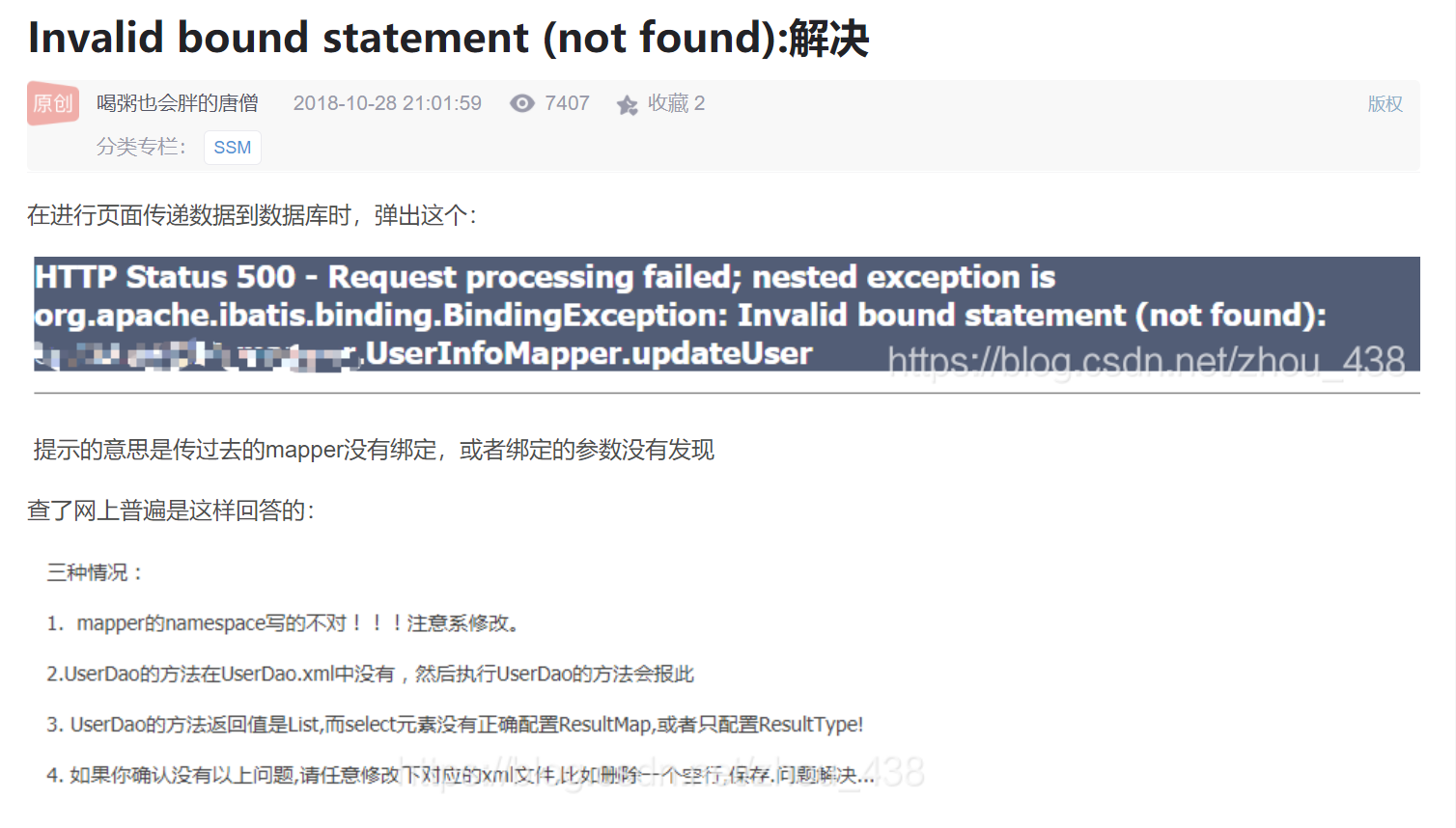
总结:
- 关联–association 多对一
- 集合–collection 一对多
- JavaType & ofType
- JavaType 用来指定实体类中属性的类型
- ofType 用来指定映射到List或者集合中的pojo类型,泛型中的约束类型
注意点:
- 保证sql的可读性,尽量保证通俗易懂
- 注意一对多和多对一的关系,属性名和字段名对应问题
- 经常用日志和debug来检查
12.动态SQL
什么是动态SQL:动态SQL就是指根据不同的条件生成不同的SQL语句
如果你之前用过 JSTL 或任何基于类 XML 语言的文本处理器,你对动态 SQL 元素可能会感觉似曾相识。在 MyBatis 之前的版本中,需要花时间了解大量的元素。借助功能强大的基于 OGNL 的表达式,MyBatis 3 替换了之前的大部分元素,大大精简了元素种类,现在要学习的元素种类比原来的一半还要少。
if
choose (when, otherwise)
trim (where, set)
foreach
搭建环境
CREATE TABLE `blog`(
`id` VARCHAR(50) NOT NULL COMMENT '博客id',
`title` VARCHAR(100) NOT NULL COMMENT '博客标题',
`author` VARCHAR(30) NOT NULL COMMENT '博客作者',
`create_time` DATETIME NOT NULL COMMENT '创建时间',
`views` INT(30) NOT NULL COMMENT '浏览量'
)ENGINE=INNODB DEFAULT CHARSET=utf8
注意,有时候写@Test注解无法使用的时候,往往是pom.xml文件中的依赖的限制了范围,可以删掉范围就为全局了,或者就在目录的test文件下写test文件(Test文件名不要写Test!!!!!!重名了容易报错),会比较规范
创建一个基础工程
-
导包
-
编写配置文件
-
编写实体类
@Data public class Blog { private String id; private String title; private String author; private Date createTime; private int views; } //Java里的时间用util.Date而不是sql里的Date包,注意不要导错 -
编写实体类对应的Mapper接口和Mapper.xml
public interface BlogMapper { //插入数据 int addBlog(Blog blog); }<mapper namespace="com.sun.dao.BlogMapper"> <insert id="addBlog" parameterType="Blog"> insert into mybatis.blog (id, title, author, create_time, views) VALUES (#{id}, #{title}, #{author}, #{createTime}, #{views}) </insert> </mapper>
课程P22的测试语句:
public class MyTest {
@Test
public void addBlogTest() {
SqlSession sqlSession = MybatisUtils.getSqlSession();
BlogMapper mapper = sqlSession.getMapper(BlogMapper.class);
Blog blog = new Blog();
blog.setId(IDutils.getId());
blog.setTitle("Mybatis");
blog.setAuthor("萌神说");
blog.setCreateTime(new Date());
blog.setViews(9999);
mapper.addBlog(blog);
blog.setId(IDutils.getId());
blog.setTitle("Java");
mapper.addBlog(blog);
blog.setId(IDutils.getId());
blog.setTitle("Spring");
mapper.addBlog(blog);
blog.setId(IDutils.getId());
blog.setTitle("微服务");
mapper.addBlog(blog);
sqlSession.close();
}
}
IF
<select id="queryBlogIF" parameterType="map" resultType="blog">
select * from mybatis.blog where 1=1
<if test="title != null">
and title = #{title}
</if>
<if test="author != null">
and author = #{author}
</if>
</select>
choose、when、otherwise
<!-- 这个相当于switch case的操作-->
<select id="queryBlogChoose" parameterType="map" resultType="blog">
select * from mybatis.blog
<where>
<choose>
<when test="title != null">
title = #{title}
</when>
<when test="author != null">
and author = #{author}
</when>
<otherwise>
and views = #{views}
</otherwise>
</choose>
</where>
</select>
trim、where、set
select * from mybatis.blog
<where>
<if test="title != null">
and title = #{title}
</if>
<if test="author != null">
and author = #{author}
</if>
</where>
<update id="updateBlog" parameterType="map">
update mybatis.blog
<set>
<if test="title != null">
title = #{title},
</if>
<if test="author != null">
author = #{author},
</if>
</set>
where id = #{id}
</update>
SQL片段
有时候,我们可能会将一些功能的部分抽取出来,方便复用
-
使用SQL标签抽取公共部分
<sql id="if-title-author"> <if test="title != null"> and title = #{title} </if> <if test="author != null"> and author = #{author} </if> </sql> -
在需要使用的地方使用include标签引用
<where> <include refid="if-title-author"> </include> </where>最好基于单表定义SQL片段
不要存在where标签
foreach
<!-- 我们现在传递一个万能map,,这个map中可以存在一个集合!
需要拼接的SQL语句:
select * from mybatis.blog where 1=1 and (id=1 or id=2 or id=3)-->
<select id="queryBlogForeach" parameterType="map" resultType="blog">
select * from mybatis.blog
<where>
<foreach collection="ids" item="id" open="and (" close=")" separator="or">
id = #{id}
</foreach>
</where>
</select>
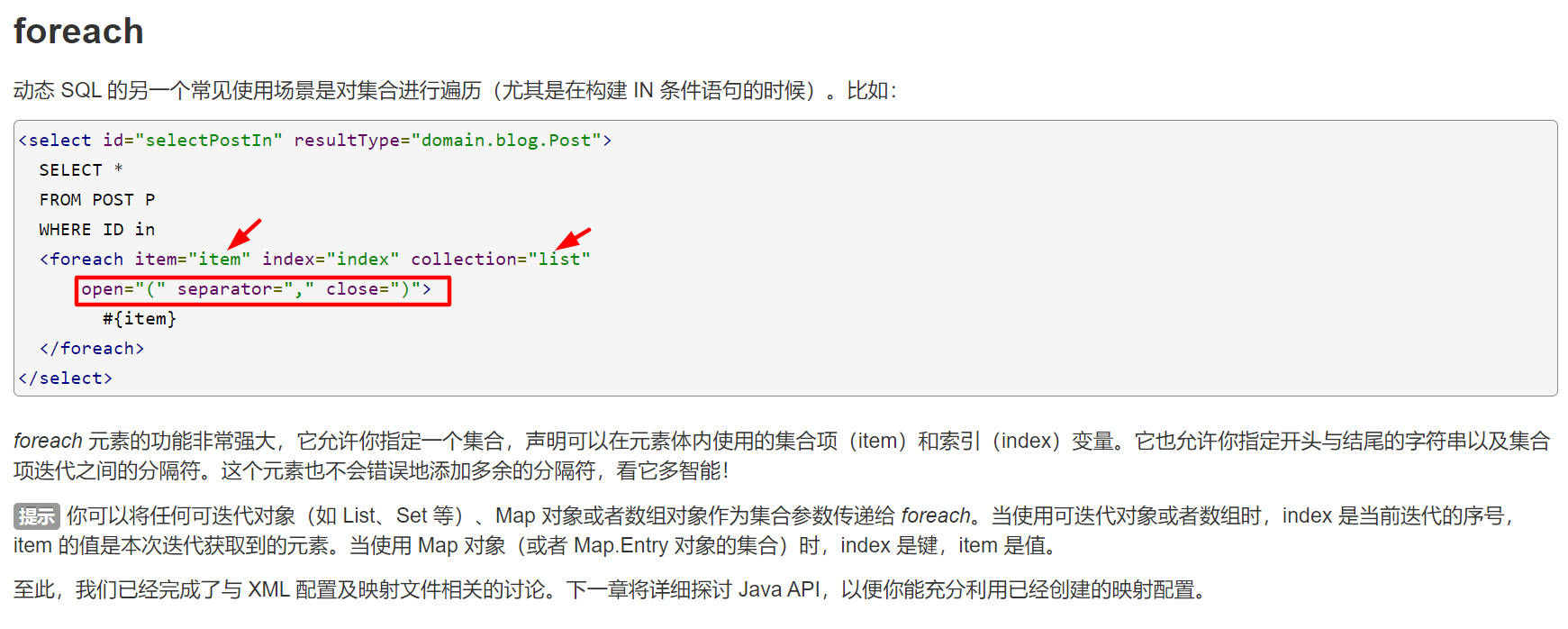
官方文档内容:平时多看多理解

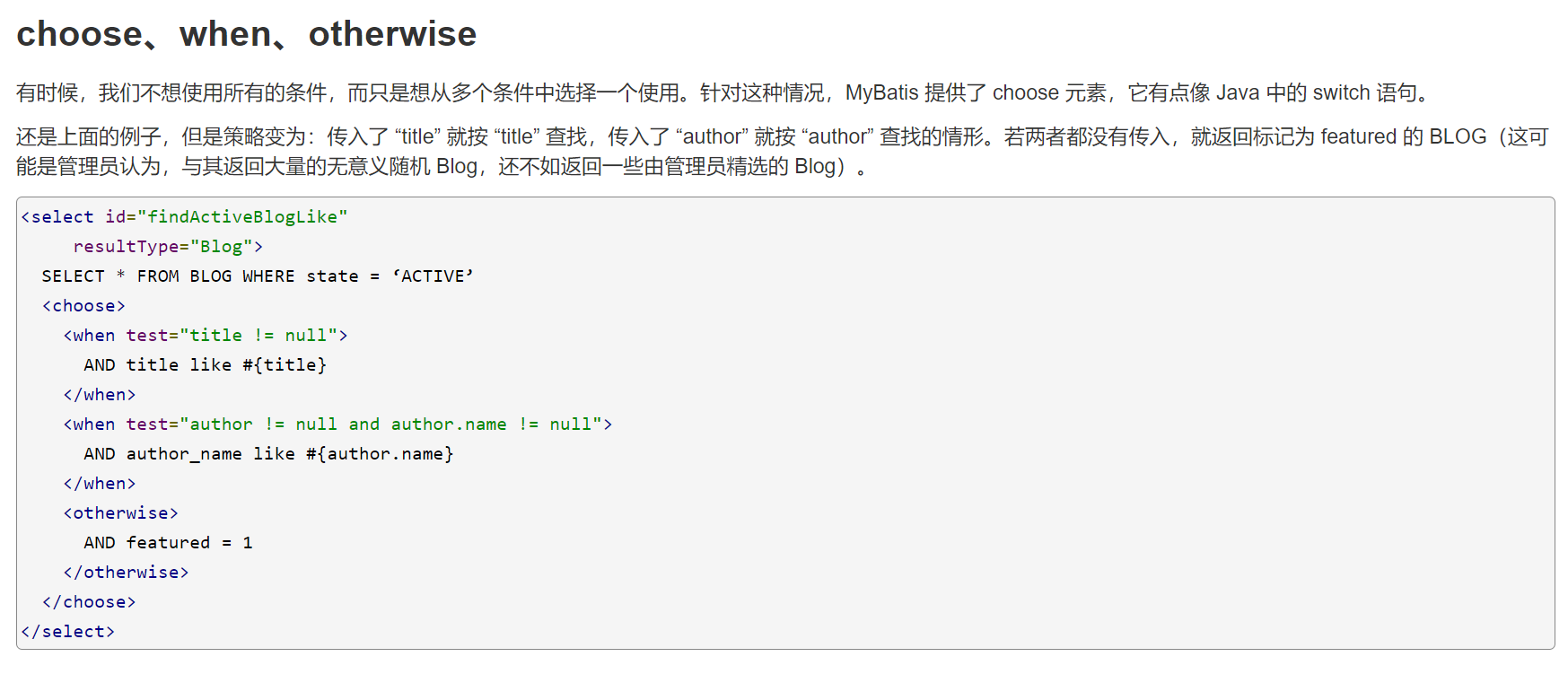
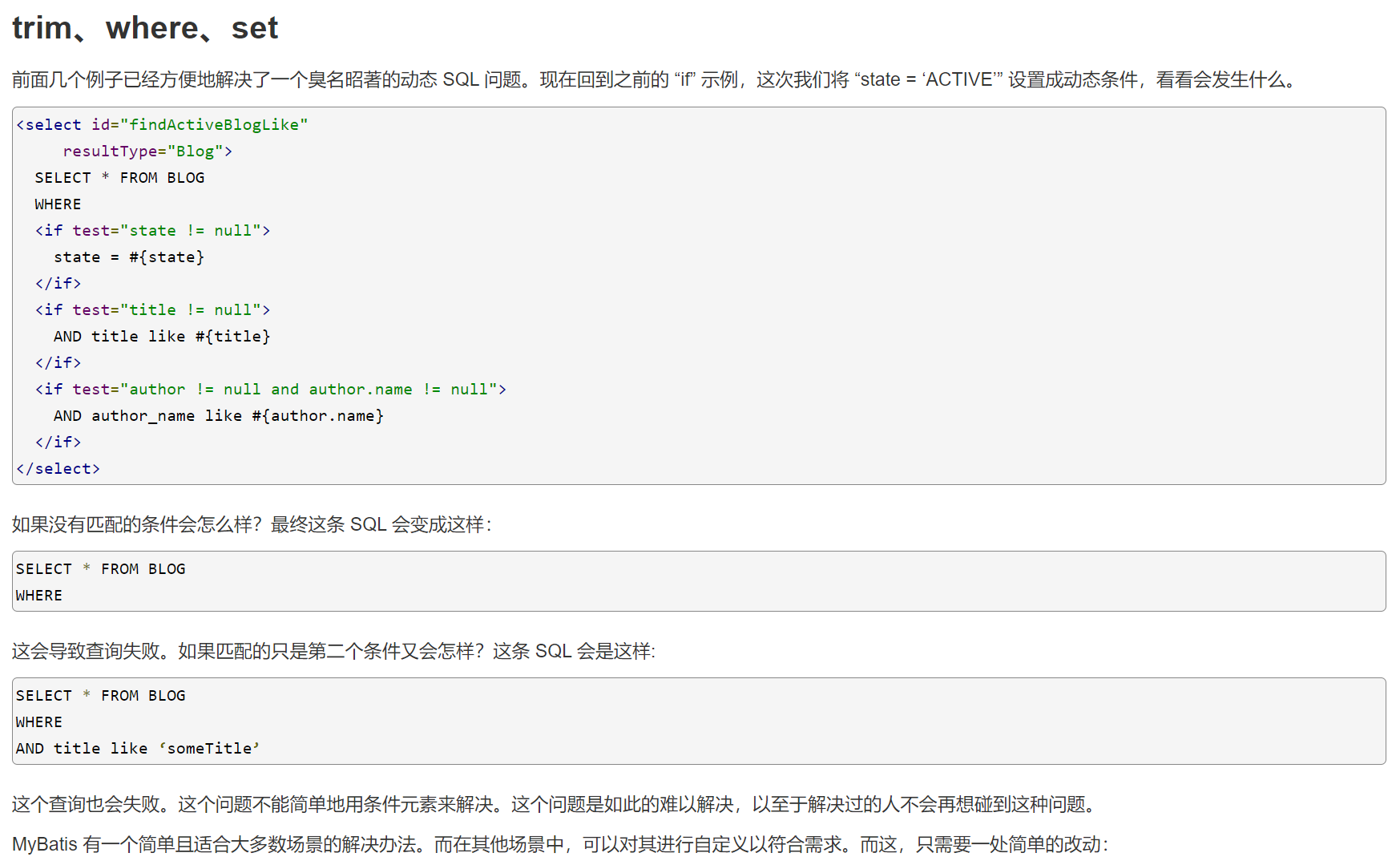

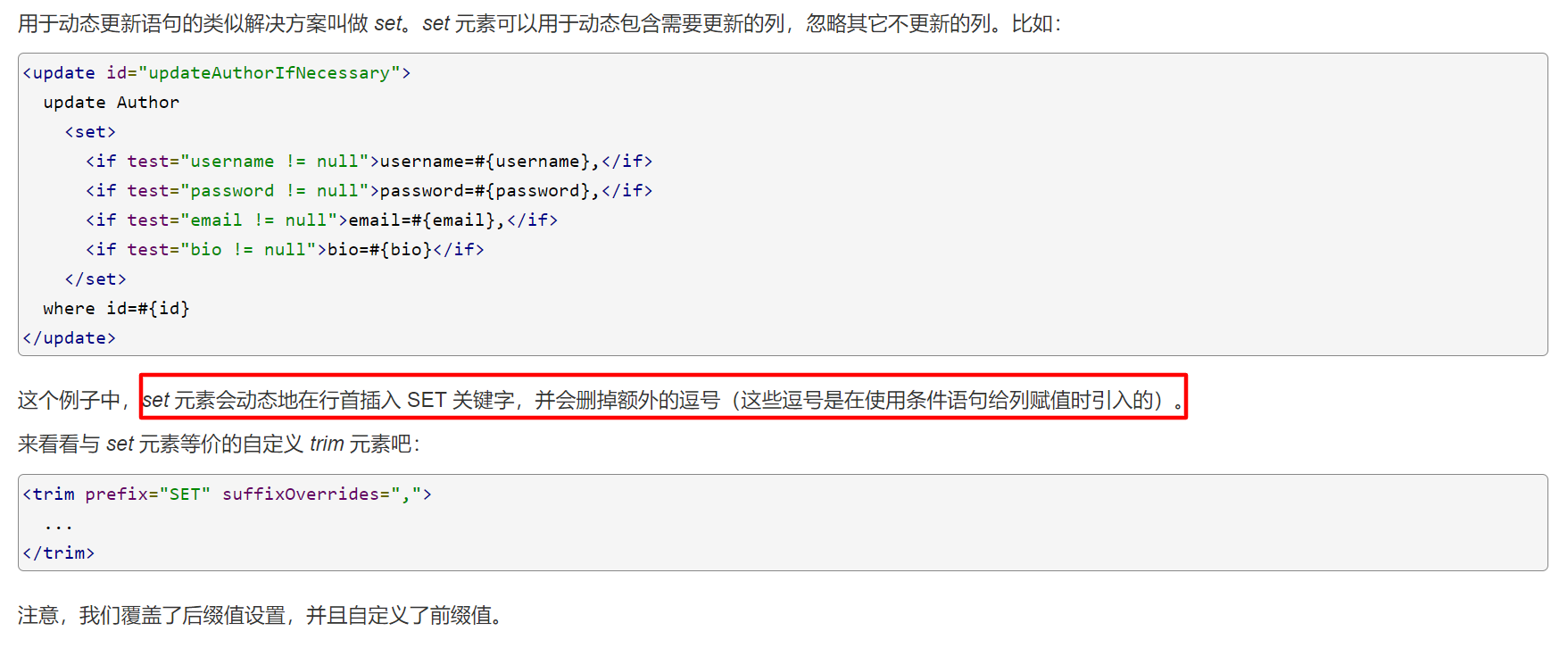
动态SQL就是在拼接SQL,保证正确的语句后进行拆分修改成正确的语句=
13.缓存
1.简介
查询: 连接数据库 , 耗费资源!
一次查询的结果可以暂存到一个可以直接读取的地方 ---> 内存:缓存
我们再次查询相同数据的时候,直接走缓存,而不用去查数据库
1.什么是缓存【Cache】?
- 存在内存中的临时数据
- 将用户查询的数据直接放在缓存中,类似于迅雷云盘和百度网盘的工作原理;可以提高查询效率,解决高并发问题
2.为什么使用缓存?
- 减少和数据库的交互次数,减少系统开销,提高系统效率
3.什么样的数据使用缓存比较好?
- 经常查询且不会经常改变的数据
2.Mybatis缓存
- MyBatis包含一个非常强大的查询缓存特性,它可以非常方便的定制和配置缓存。缓存可以极大提高查询效率
- MyBatis默认定义了两级缓存:一级缓存和二级缓存
- 默认情况下,只有一级缓存开启(SqlSession级别的缓存,也称本地缓存)
- 二级缓存需要手动开启和配置,他是基于namespace级别的缓存
- 为了提高拓展性,MyBatis定义了缓存接口Cache,我们通过Cache接口实现自定义二级缓存
3.一级缓存
-
开启日志!
-
测试在一个Session中查询两次相同记录
-
查看日志输出

缓存失效的情况:
-
查询不同的东西
-
增删改操作,可能改变原来的数据,所以必定会刷新缓存
-
查询不同的mapper
-
手动清理缓存的时候
sqlSession.clearCache();
小结:一级缓存默认开启,只在一次Session中有效(即在close前),也关不掉
一级缓存相当于map
4.二级缓存
官方文档内容:
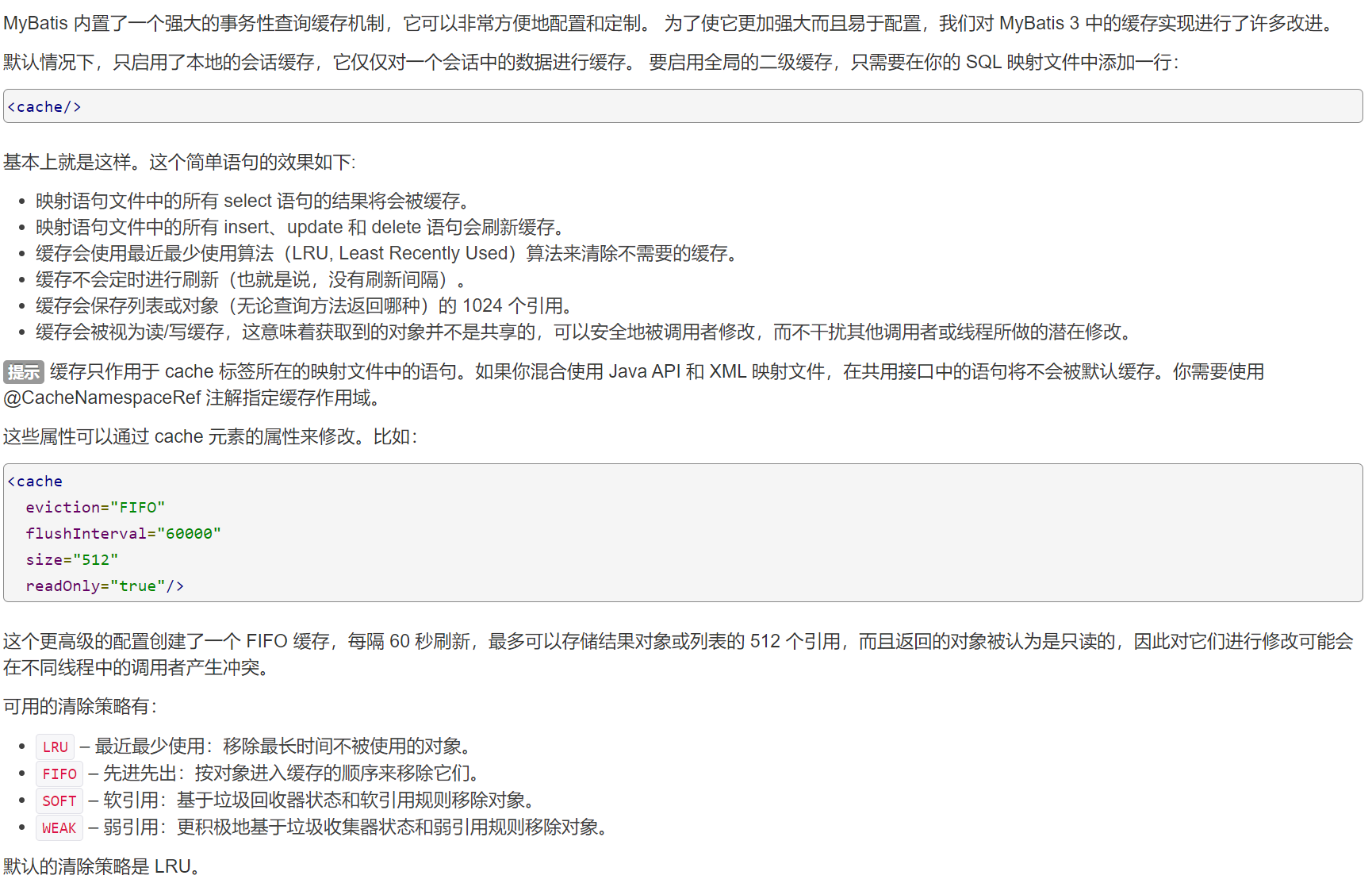
二级缓存基于namspace级别,一个命名空间对应一个二级缓存
就是在sqlsesion.close以后一级缓存已经没有了,但是可以通过二级缓存来再次查询到
步骤:
-
开启全局缓存
<!-- 开启全局缓存--> <setting name="cacheEnabled" value="true"/> -
在要使用二级缓存的mapper.xml文件中开启
<cache/>也可以自定义一些配置,像官方文档那样
<cache eviction="FIFO" flushInterval="60000" size="512" readOnly="true"/> -
测试后
我们需要将实体类序列化,否则会报错
5.缓存原理
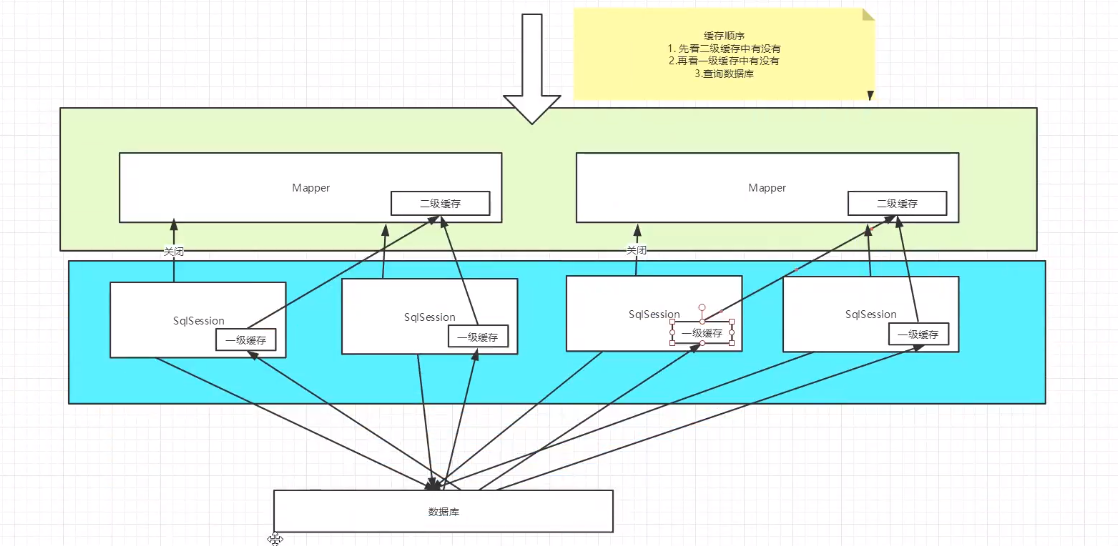
6.自定义缓存-echcache
EhCache 是一个纯Java的进程内缓存框架,具有快速、精干等特点,主要面向通用缓存
仅仅了解,之后要学redis
13.缓存
1.简介
查询: 连接数据库 , 耗费资源!
一次查询的结果可以暂存到一个可以直接读取的地方 ---> 内存:缓存
我们再次查询相同数据的时候,直接走缓存,而不用去查数据库
1.什么是缓存【Cache】?
- 存在内存中的临时数据
- 将用户查询的数据直接放在缓存中,类似于迅雷云盘和百度网盘的工作原理;可以提高查询效率,解决高并发问题
2.为什么使用缓存?
- 减少和数据库的交互次数,减少系统开销,提高系统效率
3.什么样的数据使用缓存比较好?
- 经常查询且不会经常改变的数据
2.Mybatis缓存
- MyBatis包含一个非常强大的查询缓存特性,它可以非常方便的定制和配置缓存。缓存可以极大提高查询效率
- MyBatis默认定义了两级缓存:一级缓存和二级缓存
- 默认情况下,只有一级缓存开启(SqlSession级别的缓存,也称本地缓存)
- 二级缓存需要手动开启和配置,他是基于namespace级别的缓存
- 为了提高拓展性,MyBatis定义了缓存接口Cache,我们通过Cache接口实现自定义二级缓存
3.一级缓存
-
开启日志!
-
测试在一个Session中查询两次相同记录
-
查看日志输出
[外链图片转存中…(img-cAqs6qeL-1612268827431)]
缓存失效的情况:
-
查询不同的东西
-
增删改操作,可能改变原来的数据,所以必定会刷新缓存
-
查询不同的mapper
-
手动清理缓存的时候
sqlSession.clearCache();
小结:一级缓存默认开启,只在一次Session中有效(即在close前),也关不掉
一级缓存相当于map
4.二级缓存
官方文档内容:
[外链图片转存中…(img-rpcxXAPH-1612268827432)]
二级缓存基于namspace级别,一个命名空间对应一个二级缓存
就是在sqlsesion.close以后一级缓存已经没有了,但是可以通过二级缓存来再次查询到
步骤:
-
开启全局缓存
<!-- 开启全局缓存--> <setting name="cacheEnabled" value="true"/> -
在要使用二级缓存的mapper.xml文件中开启
<cache/>也可以自定义一些配置,像官方文档那样
<cache eviction="FIFO" flushInterval="60000" size="512" readOnly="true"/> -
测试后
我们需要将实体类序列化,否则会报错
5.缓存原理
[外链图片转存中…(img-GrDvKqxm-1612268827433)]
6.自定义缓存-echcache
EhCache 是一个纯Java的进程内缓存框架,具有快速、精干等特点,主要面向通用缓存
仅仅了解,之后要学redis





















 4万+
4万+











 被折叠的 条评论
为什么被折叠?
被折叠的 条评论
为什么被折叠?








